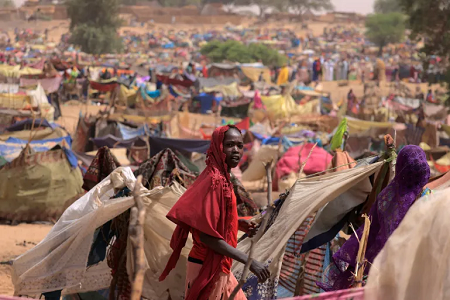Sudan: Displacement Crisis amid Conflict and Climate Change

The outbreak of armed conflict in Sudan in mid-April last year between the army and the Rapid Support Forces (RSF) has killed thousands of civilians, displaced millions, looted property and recruited child soldiers as the fighting spread from the capital to more areas of the country. According to the latest estimates, civilian deaths have risen to more than 15,000, the number of people who have fled and abandoned their homes and property has reached 8.8 million, with nearly 6.8 million internally displaced persons (IDPs) taking refuge in 7,251 locations. The UN has described the situation as “the largest displacement crisis in the world, potentially surpassing Syria`s crisis of 7.2 million IDPs.
The greatest portion of the displaced, about 53% (3.6 million), are from Khartoum State, followed by South Darfur (14%), al-Jazira (10%), North Darfur (9%), Central Darfur (4%), and other states. More than two million people have fled across the Sudanese borders, including 660,000 into South Sudan, 579,000 to Chad, and 500,000 to Egypt.
Since April 2023, systematic RSF arson attacks continue to destroy villages and settlements across western Sudan. April 2024 was the worst month on record for such fires, with 72 villages destroyed, bringing the total number of affected settlements to 201 since the start of the war. This past April, RSF violence against civilians increased to 1,400 cases, with 160 new cases, representing a 30% increase from the previous four weeks.
The deteriorating security situation and restrictions on movement are major barriers to relief and protection services, exacerbating abuses against women and girls in the form of sexual harassment, abduction and rape. Key challenges in the region include food insecurity and lack of livelihood resources, with nearly 5 million people on the brink of famine and 17.7 million facing acute food insecurity due to conflict, economic instability and rising food prices. Already rising hunger and acute malnutrition are expected to increase related deaths in the coming months.
Most incidents of violence against civilians are ethnically based, targeting non-Arab Sudanese, and may amount to ethnic cleansing, concentrated in al-Jazira and North Darfur states. Violent attacks against civilians included extrajudicial killings, torture, widespread destruction of property and looting that has disproportionately targeted Zaghawa ethnic communities.
Military maneuvers have been similar to those deployed during the 2003 counter-insurgency campaign when the ethnically Arab and semi-nomadic Janjaweed militias targeted such non-Arab ethnic groups in Darfur as Masalit in al-Janaina in West Darfur and Zaghawa, forcing more than half a million people to flee to neighboring Chad.
Hundreds of thousands of displaced people fleeing violence elsewhere in Darfur and finding refuge in al-Fashir town have been targeted. The conflict in al-Fashir, North Darfur’s capital, since last April is one of the worst cases, resulting in the displacement of an estimated 505,000 people due to the systematic destruction of entire villages in the region. The majority of these IDPs are now hosted in three main locations, with more than 100 overcrowded IDP camps in the southern part of al-Fashir. In response, the UN Security Council The UN Security Council adopted a resolution that called for the paramilitary Rapid Security Forces (RSF) in Sudan to halt their siege on al- Fashir, but the carnage and the displacement continue.
Sudan already had regressed from a lower-middle-income country to a low-income rating in 2020. The ongoing conflict has further reduced household incomes by more than 40% in both urban and rural areas across Sudan, resulting in an estimated 1.8 million more Sudanese living in poverty since last year. Lack of access to, and consumption of safe drinking water remains a serious concern, especially for civilians in conflict areas, including in the Darfur, Khartoum and Kordofan, due to prolonged power outages and attacks on water treatment plants.
The inadequate international political and humanitarian response to the conflict and the failure to prioritize the protection of civilians only ensures that warring parties are yet to be held accountable for their blatant disregard for international humanitarian law. The true scale of the crisis remains invisible, as fear of reprisals and distrust of local institutions have resulted in severe underreporting.
Moreover, the effects of climate change are deepening the IDP crisis, with unprecedentedly heavy seasonal flooding having destroyed hundreds of homes and IDP shelters, especially in northern Sudan since 2022. The IDPs camps, the locus of one of the world`s most-neglected crises of 2021, were inundated and suffered 146 fatalities and more than 122 people injured since the beginning of the rainy season in June. And all this came amid skyrocketing prices and gaps in humanitarian funding.
Back in May to the end of September 2022, heavy rains brought flooding that affected around 349,000 people, destroyed at least 24,800 homes and damaged another 48,200 in 16 out of the 18 states. The most affected state has been Northern (34,000 people), followed by River Nile (19,000), North Darfur (13,000), South Darfur (16,000), Qadarif (2,000), White Nile (2,000), North Kordofan (1,000), Red Sea (1,000), and South Kordofan (1,000).
HLRN’s 2022 World Habitat Day report from the Violation Database featured this disproportionate victimization of IDPs amid climate change due to their systematic neglect and marginalization. (See In Pursuit of Climate Justice: Housing and Land Rights Violations in the Context of Environmental Hazards and Climate Change, pp. 4–5.)
Reports now indicate that at least 8,227 homes have been destroyed and 7,540 damaged in extreme climate events since October 2023. And all these slow-onset and extreme weather events have coincided with another human-made disaster: war.
See also:
Annual Report of the UN Secretary-General, “Children and Armed Conflict,” A/78/842-S/2024/384, 3 June 2024
Photo: A Sudanese girl who fled the conflict in Darfur region and was previously internally displaced in Sudan moves past makeshift shelters near the border between Sudan and Chad. Source: Zohra Bensemra/Reuters.
|